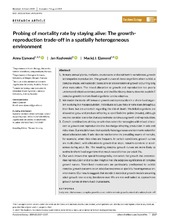| dc.contributor.author | Ejsmond, Anna | |
| dc.contributor.author | Kozłowski, Jan | |
| dc.contributor.author | Ejsmond, Maciej Jan | |
| dc.date.accessioned | 2020-08-06T09:29:55Z | |
| dc.date.available | 2020-08-06T09:29:55Z | |
| dc.date.issued | 2019 | |
| dc.Published | Ejsmond A, Kozłowski J, Ejsmond MJ. Probing of mortality rate by staying alive: The growth-reproduction trade-off in a spatially heterogeneous environment. Functional Ecology. 2019;33(12):2327-2337 | eng |
| dc.identifier.issn | 1365-2435 | en_US |
| dc.identifier.issn | 0269-8463 | en_US |
| dc.identifier.uri | https://hdl.handle.net/1956/23508 | |
| dc.description.abstract | 1. In many annual plants, mollusks, crustaceans and ectothermic vertebrates, growth accompanies reproduction. The growth curves of these organisms often exhibit a complex shape, with episodic cessations or accelerations of growth occurring long after maturation. The mixed allocation to growth and reproduction has poorly understood adaptive consequences, and the life‐history theory does not explain if complex growth in short‐lived organisms can be adaptive. 2. We model the trade‐off between growth and reproduction in a short‐lived organism evolving in a metapopulation. Individuals occupy risky or safe sites throughout their lives, but are uncertain regarding the risk of death. Modelled organisms are allowed to grow and produce offspring at specified time points (moults), although we also consider scenarios that approximate continuous growth and reproduction. 3. Certain combinations of risky to safe sites select for strategies with mixed allocation to growth and reproduction that bet‐hedge offspring production in safe and risky sites. Our model shows that spatially heterogeneous environments select for mixed allocation only if safe sites do not become the prevailing source of recruits, for example, when risky sites are frequent. In certain conditions, growth curves are multi‐phasic, with allocation to growth that stops, remains constant or accelerates during adult life. The resulting complex growth curves are more likely to evolve in short‐lived organisms that moult several times per adult life. 4. Our work shows that spatial heterogeneity can select for growth that accompanies reproduction and provides insights into the adaptive significance of complex growth curves. Short‐lived crustaceans are particularly predisposed to exhibit complex growth patterns as an adaptive response to spatially heterogeneous environments. Our results suggest that standard statistical growth models assuming adult growth rate to only decelerate over life are not well suited to approximate growth curves of short‐lived crustaceans. | en_US |
| dc.language.iso | eng | eng |
| dc.publisher | Wiley | en_US |
| dc.rights | Attribution CC BY | eng |
| dc.rights.uri | http://creativecommons.org/licenses/by/4.0 | eng |
| dc.title | Probing of mortality rate by staying alive: The growth-reproduction trade-off in a spatially heterogeneous environment | en_US |
| dc.type | Peer reviewed | |
| dc.type | Journal article | |
| dc.date.updated | 2020-01-17T09:35:51Z | |
| dc.description.version | publishedVersion | en_US |
| dc.rights.holder | Copyright 2019 The Author(s) | en_US |
| dc.identifier.doi | https://doi.org/10.1111/1365-2435.13442 | |
| dc.identifier.cristin | 1748291 | |
| dc.source.journal | Functional Ecology | |
| dc.identifier.citation | Functional Ecology. 2019, 33 (12), 2327-2337. | |

